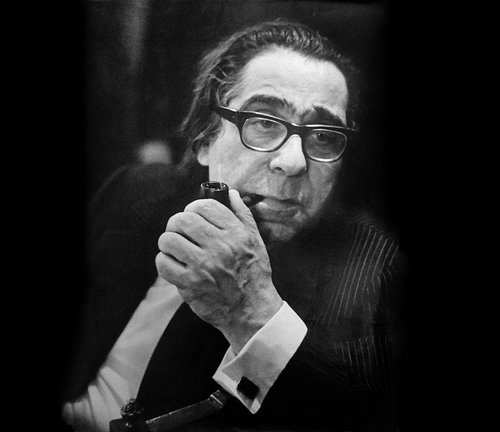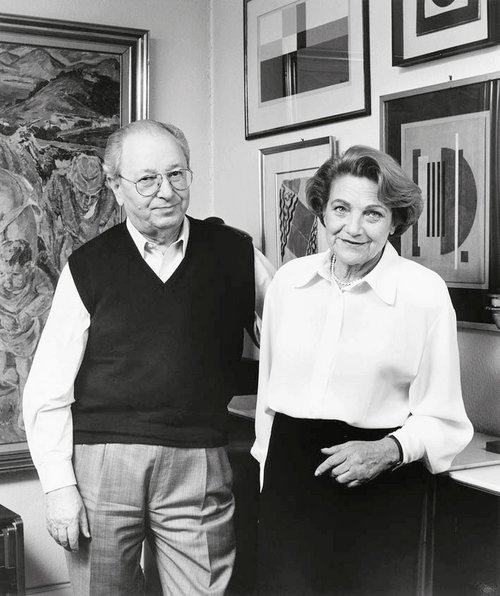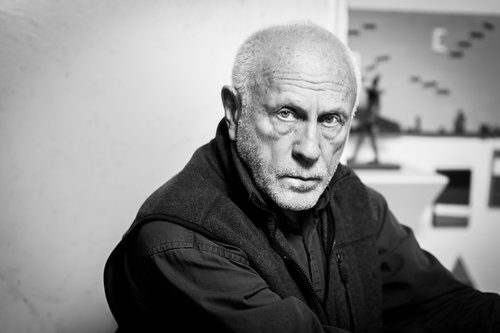Me Too: Jack Melkonian and A–Ya Magazine

Jack Melkonian at Costakis apartment. Courtesy of Jack Melkonian
In the 1960s and 70s Jack Melkonian became a collector of underground Eastern European and Russian art and financed the first edition of the Russian magazine A–Ya which brought Russia’s non-conformist artists to western audiences at a time when they were barely known. Recently Jo Vickery caught up with him in Geneva where he spoke to her about the highs and lows of his personal encounters with the Soviet underground.
I meet Jack in the bar of the Hotel Metropole by the shore of Lake Geneva, on a beautifully sunny September morning. It’s mid-week, the hotel bar is nearly empty, perfect for an unhurried conversation about the past. Jack looks decades younger than his 88 years, his trim frame has perfect posture, eyes full of life. Even before globalisation was a word, Jack was a true cosmopolitan: ‘I was born in London, my mother was Swiss-German, my father Armenian’ he explains as if it were quite commonplace for a child of the 1930s. Yet, it was Italy that first ‘made the man’, in the 1950s he fell in love with Italian haut couture and wanted to become a designer, taking courses in Milan, something his father frowned on and perhaps led him eventually down a slightly more sanguine career path if even more niche: he became a textile engineer. It was as a textile engineer that he eventually found his way into what was at the time an even more niche, undiscovered world, that of underground art circles in the Soviet bloc.
It started out when Jack went to Poland in the 1960s and met his first wife there, ‘I became integrated into Polish society at the time’ he says. He discovered the Foksal Gallery in the centre of Warsaw, set up by Wiesław Borowski, and remembers visiting the architecture club next door where he would drink coffee and eat caviar and where he met Polish underground artists. It was a first encounter with Tadeusz Kantor (1915–1990) which he talks of with most enthusiasm, an artist whose works he began to acquire for himself in the seventies. It was a lot of fun. He smiles when telling me about when he unrolled a large painting by Kantor on the floor in his wife’s house in Poznan that their son’s nanny was so shocked she crossed herself in front of it. On another occasion, Kantor visited him and said ‘Jack, I have an invisible painting for you!’. It was an empty, raw canvas signed and dated on the back. ‘Of course, he did not expect me to pay for it’. Another of his favourite episodes happened when he was working for Dupont in Geneva, a stint which lasted one year. The company had produced some paper which was impossible to tear which no-one wanted to buy so they needed to get rid of it. Jack bundled an 80kg roll into his car and took it to Prague and gave it to Kantor. Later, he noticed the artist had made a large construction in his workspace to hold the paper to make costumes out of it for one of his plays, now in the Cricoteka collection ‘he said he liked the sound of the paper when it moved’ reflects Jack.
His journey into Russian underground circles was motivated in part because of his experiences in Poland, where he began to be asked by the artists at Foksal what was happening in Russia. His initial trips to Soviet Russia had felt like a closed door, ‘The only work by Chagall I knew was from the National Gallery in Yerevan’ he jokes. It was thanks to a contact at the American embassy in London that he eventually got the phone number of George Costakis. ‘He was a connoisseur, not an intellectual and although he could not speak deeply about the art hanging on his walls, he had a great eye and could discern true quality’, recalls Jack.
During one visit to the apartment in Vernadsky Prospect he saw one work which attracted his attention, a cubist style sculpture on the floor by a young Russian artist called Igor Shelkovsky (b. 1937). ‘It was the first work of art I ever saw by a contemporary artist, not the usual kind of political work I saw in Russia at the time. I asked Costakis many times about it on subsequent visits and finally he introduced me to Shelkovsky and eventually I bought many works by him for my collection’.
He talks about how Costakis introduced him to Sergei Essaian (1939–2007), an Armenian artist based in Moscow, who spoke excellent English and French, a suitable guide for Jack through the underground circles. He remembers Essaian trying to leave the Soviet Union, ‘I arrived in Moscow on one trip and Essaian was wearing the cross of Judea and it turned out that as a Jew it was possible to leave the Soviet Union and this was his hope’. There was an organisation which would help you leave and you first went to Vienna then got papers and travel tickets to Israel for permanent settlement. People who changed their mind after leaving Russia, who preferred to stay in Europe, such as Rimma Gerlovina (b. 1951) found themselves without any financial support. Essaian and his family stayed in an apartment belonging to Jack’s father for a year as they found their feet in Paris.
It is perhaps not so much as a collector but for his role in the origins of A–Ya magazine that Jack’s contribution ought not to be forgotten today. He tells me that the idea behind the magazine was born out of the Venice Biennale of Dissent in 1977, an exhibition of dissident art from across the Eastern bloc. Ironically, the Biennale lived up to its name for all the wrong reasons, provoking so much controversy in Italy that it was only given the go-ahead on the grounds that it would take place outside of the tourist season, when hardly anyone would be in Venice to see it. The local Socialist party was supportive but it came under intense pressure from both the Communist party in Italy and the Russian communist party who was incensed, seeing it as a kind of betrayal, and the Soviet Embassy tried to have it closed down. Jack remembers sitting at a round table discussion during the opening of the Biennale, and hearing the voice of Ernst Neizvestny (1925–2016) in words Jack now spells out to me as if perfectly etched on his own memory in stone: ‘We in Russia have a dual blood stream: we have the official one and we have the unofficial one’.
By this time, Jack and Shelkovsky who had become friends and visited the Biennale together shared their disappointment about what was in reality a lack of visibility for the artists within the limits of a brief month-long exhibition. ‘It got us thinking about how to create an enduring and accessible source of information about Soviet underground art. We had a few ideas, like establishing a cultural centre in Geneva, but we were not sure who would be able to take care of it and then finally we thought of doing a magazine’. By then Igor Shelkovsky had moved to Paris. On Jack’s next trip to Moscow, he met with Rimma Gerlovina and Alex Sidorov, and they had a brainstorming session about the idea of the magazine and decided they needed a name. ‘We came up with the name together, we liked the nuance that it carries in Russian because as well as representing the first and last letters of the Cyrillic alphabet, taken colloquially it means ‘But what about me?’
There were risks involved. ‘In order to protect my identity and ensure that I could continue to travel back and forth to Russia, my friends came up with a pseudonym, Boris Karmashov, which appeared in the first edition of the magazine which we published in 1979’. Together Jack and Sidorov sought traction among the artists in the underground circles for contributions, although Sidorov was essentially a jewellery restorer, as a foreigner, Jack had a certain allure, and together the pair managed to get support. ‘Sidorov collected the information and I sent it to Igor Shelkovsky in Paris’. Jack financed the very first edition – later the publication evolved and attracted wider support notably of French gallerist Dina Vierny. ‘Alex Kosolapov helped to disperse it in the USA, we shipped about a thousand copies to his address in New York. I assembled a database of museum contacts around the world and brought copies sometimes myself, but I remember at a museum in San Francisco I was simply turned away, no-one wanted to stock it in the museum bookshop’.
Remarkably, at no point in our discussion does Jack resort to any kind of idealisation of the past, painting a picture of the Moscow underground circles for all their sense of battling for freedom of conscience as being flawed, at times arrogant and full of petty intrigues. Even those who were pioneering promoters of the art in the West were not immune to self-aggrandizement: ‘Alexander Glezer liked to see himself as the one who introduced non-conformist art to the West, and he did a lot especially for Jewish Russian artists, but there were many intrigues in the Russian underground circles especially among those who had settled abroad’. It could be hurtful - once Jack read an article by his old friend and collaborator Igor Shelkovsky who wrote that he believed Jack might even have been connected to the KGB. ‘It was absurd, thankfully other friends of mine from those years in the underground like Eric Bulatov (b. 1933) and David Sarkisian (1947–2010) batted this off in public’.
Jack was the kind of collector who gathered art which was produced around him and in which he felt an emotional involvement. ‘All of the art that I collected over many decades was created during one era and has a kind of patina which I found extremely interesting and still do today’. He believes that Eastern European and Russian art later changed for the worse as or perhaps because it became commercial. But thinking of the late Soviet times, I often wonder how true it is that the art was completely devoid of any market influence, even if that currency was not always money but television sets or nylon tights, and Jack talks of ‘dipart’ – art made for the foreign diplomats who lived in Russia for many years and they were able to take the art out of Russia with them when they left.
‘Many artists like that just disappeared into obscurity whereas there were a few diplomats who did go on to create worthy collections like the Swiss attaché Martin Von Walterskirchen and his wife Ursula who knew Ilya Kabakov (1933–2023) and acquired his work’. Jack collected art from all across the Eastern Bloc, such as Romania, Hungary and Poland which gave him some broad perspectives on the region. Today as he looks back he is convinced that the existence of a certain basic if meagre art infrastructure in the eastern bloc countries like Poland had a beneficial effect on the unofficial art production there, something which was completely absent in Soviet Russia. It created a situation where, he felt Russia’s underground artists were a little more lost, without a compass and with a tendency to excessive re-invention.
























